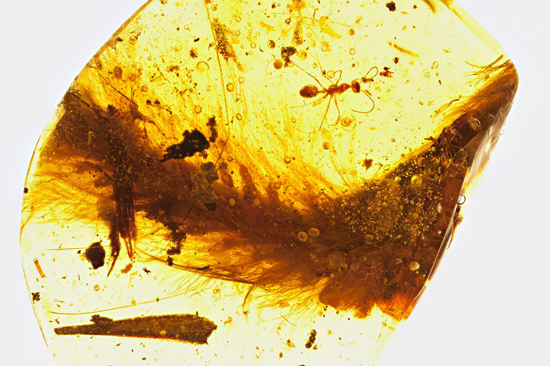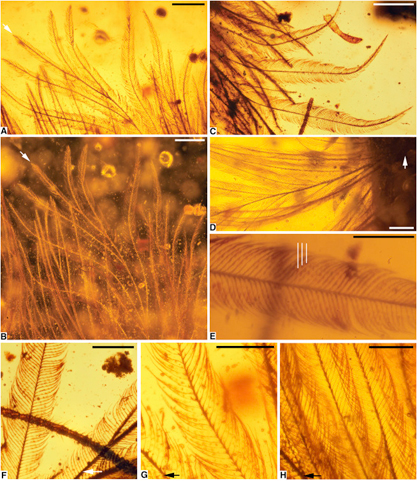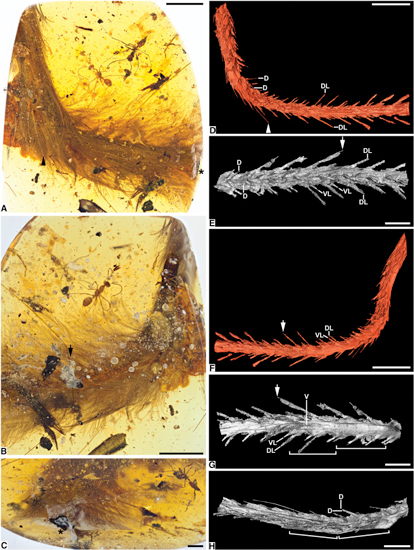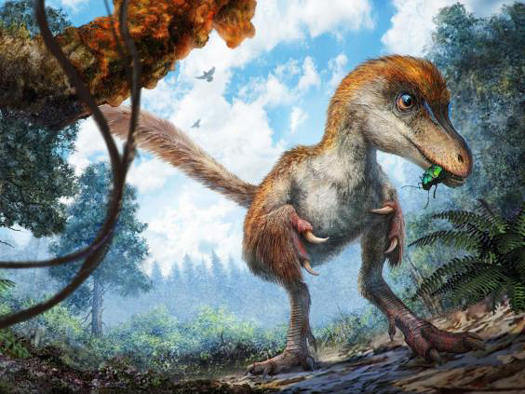The Remarkable Tale of a Dinosaur Tail
Dinosaur Tail Preserved in Mid-Cretaceous Amber
A team of international scientists including Lida Xing (University of Geosciences, Beijing), Phil Currie (University of Alberta), Michael Benton (University of Bristol), Ryan McKellar (Royal Saskatchewan Museum) and Xing Xu (Institute of Vertebrate Palaeontology and Palaeoanthropology) have published a paper describing the discovery of a partial dinosaur tail preserved in amber.
The Dinosaur Tail Segment Preserved in Burmite (Amber from Myanmar)
Picture credit: R. McKellar/Royal Saskatchewan Museum
It is the first time that non-avian theropod remains have been found preserved in amber and this remarkable fossil find may help scientists to uncover more information about dinosaur biology and the evolution of plumage.
Views of the Preserved Dinosaur Tail
Picture credit: Elsevier Ltd (Current Biology)
The picture above shows various photomicrographs of the plumage of the fossilised tail (specimen number DIP-V-15103). The exquisite details of the individual feathers and the barbs and barbules that help to “zip” the feather together can be made out. This fossil find confirms the theory long held by evolutionary biologists that the branching structures of feathers evolved before a modern-looking rachis (central shaft).
Photomicrographs of DIP-V-15103 Plumage
(A) Pale ventral feather in transmitted light (arrow indicates rachis apex) – scale bar = 1 mm.
(B) Dark-field image of (A), highlighting structure and visible colour – scale bar = 0.5 mm.
(C) Dark dorsal feather in transmitted light, apex toward bottom of image – scale bar = 0.5 mm.
(D) Base of ventral feather (arrow) with weakly developed rachis, scale bar = 0.5 mm.
(E) Pigment distribution and microstructure of barbules in (C), with white lines pointing to pigmented regions of barbules, scale bar 0.5 mm.
(F–H) Barbule structure variation and pigmentation, among barbs, and ‘rachis’ with rachidial barbules (near arrows); images from apical, mid-feather, and basal positions respectively, scale bars 0.25 mm.
An analysis of the preserved pigmentation signatures suggests that this little dinosaur’s tail was a light chestnut colour with a paler, or possibly white underside.
Definitely a Dinosaur
Lida Xing, the lead author of the study, discovered the remarkable fossil at an amber market in Myitkina (Kachin State, northern Myanmar). The 99-million-year-old amber had already been polished for jewellery and the retailer had thought that the “furry looking” object visible inside the polished piece was plant remains.
However, on closer inspection, it turned out to be the tail of a feathered dinosaur about the size of a sparrow. It was then a case of detective work, with Lida Xing eventually tracking down the amber miner who had originally found the specimen. Once the team had an idea of the location of the fossil find, they could begin the process of analysing the remains, knowing that what was inside had lived during the Middle Cretaceous.
Scanning electron microscopy permitted the team to view the skeletal structure of the tail. The caudal vertebrae (tail bones) are not fused into a stiff rod, nor are the vertebrae compressed into a pygostyle (the last five tail bones much reduced and fused into a plate of bone, the pygostyle, birds more advanced than Archaeopteryx of the Late Jurassic had a pygostyle), as in extant birds and their close relatives. This tail was long and flexible with keels of feathers running down each side – the tail of a small dinosaur.
Treasures Preserved in Burmite
Earlier this year, Everything Dinosaur reported upon the discovery of bird wings preserved in burmite (the term used to describe amber from Myanmar, which was formerly called Burma), the researchers, many of whom collaborated on the study of the dinosaur tail, identified the tiny wings of a hatchling bird that had become trapped in sticky tree resin.
The wing fossil came from a bird that was a member of the Enantiornithes group of birds. Enantiornithes are the most widespread, diverse and abundant type of bird known from the Mesozoic. Like the more primitive Confuciusornithids, these birds had pygostyles, the long sinewy tail preserved in this piece of amber strongly suggests that this is a piece of a dinosaur, albeit a small piece the tail measures just 36.73 mm long.
Views of the Dinosaur Tail Preserved in Amber
Picture credit: Elsevier Ltd (Current Biology)
To read Everything Dinosaur’s earlier article (June 2016), about the bird wings preserved in amber: Bird Wings Preserved in Amber from Myanmar.
The picture above shows photomicrographs and synchrotron radiation X-ray images of the tail.
(A) Dorsolateral overview (view from the top) – note the insect remains also found within the amber nodule, burmite has provided palaeontologists with a large number of insect specimens to study. Scale bar = 5 mm.
(B) Ventrolateral overview (view from underneath) with decay products (bubbles in foreground, staining to lower right). Scale bar = 5 mm.
(C) Caudal exposure of tail showing darker dorsal plumage (top), milky amber, and exposed carbon film around vertebrae (centre). Scale bar = 2 mm.
(D–H) Reconstructions focusing on dorsolateral, detailed dorsal, ventrolateral, detailed ventral, and detailed lateral aspects of tail, respectively, showing layout of the vertebrae and the orientation of feathers. Scale bar in (D) and (F) = 5 mm. Scale bar in (E), (G) and (H) = 2 mm.
Asterisks in (A) and (C) indicate carbonised film (soft tissue) exposure. Arrows in (B) and (E)–(G) indicate shared landmark, plus bubbles exaggerating rachis dimensions; brackets in (G) and (H) delineate two vertebrae with clear transverse expansion and curvature of tail at articulation. Abbreviations for feather rachises: d, dorsal; dl, dorsalmost lateral; vl, ventralmost lateral; v, ventral.
Vestiges of Organic Remains from a Dinosaur Tail
Chemical analysis of the carbonised soft tissues where the tail was exposed at the surface of the amber nodule indicate traces of ferrous iron Fe+2, this suggests that the specimen may contain vestiges of haemoglobin, a relic of the blood of a dinosaur. It had been rumoured that other remains of vertebrates had been found in burmite, but these pieces quickly found their way into the hands of private collectors and they were lost to science. This piece remains unique in that preserved dinosaur remains in amber have come to the attention of the scientific community and a study has been undertaken.
How Did it Get There?
Dr Ryan McKellar (Royal Saskatchewan Museum), stated that the dinosaur tail was not dried out or desiccated when it was trapped in the tree resin. This suggests that a little dinosaur became stuck in the resin when it was still alive. Co-author, Professor Mike Benton (Bristol University) commented:
“It’s amazing to see all the details of a dinosaur tail – the bones, flesh, skin, and feathers – and to imagine how this little fellow got his tail caught in the resin, and then presumably died because he could not wrestle free.”
The resin was presumably coming out of a wound in a coniferous tree, either running down the truck or lodging in a branch. This suggests that this little dinosaur may have been arboreal, a tree dweller. It has long been thought that there were a large number of small types of theropod dinosaur, but the fossil record for such small, forest dwelling reptiles is virtually non-existent.
A spokesperson from Everything Dinosaur stated:
“It is likely that there were many different types of insectivorous theropod dinosaur, inhabiting woodland habitats, but their delicate bones and the fact that forest corpses have a very limited fossil preservation potential, greatly reduces the chances of palaeontologists being able to study their remains. These types of dinosaurs are likely to be severely underrepresented in the fossil record.”
What Sort of Dinosaur?
Although feathers have been found preserved in amber before, the lack of skeletal remains associated with them frustrated scientists when it came to identifying what sort of creature the feathers belonged to. However, in this case, with the tail segment and its preserved caudal vertebrae, the researchers can confidently assign this specimen to the Dinosauria, but what type of dinosaur was it?
An Artist’s Reconstruction of the Little Feathered Dinosaur
Picture credit: Cheung Chung-Tat
Arboreal Dinosaurs
In the artist’s reconstruction, the dinosaur is depicted as a ground dwelling animal, however, team members at Everything Dinosaur don’t rule out the idea of an arboreal dinosaur becoming stuck in the tree resin. A spokesman for the Cheshire based company explained:
“A number of dinosaurs show adaptations for climbing indicating that they were at least, partially arboreal. You would have been more likely to have encountered tree resin on a resin producing tree such as a conifer and whilst we can’t completely rule out the idea that a ground dwelling dinosaur was unlucky enough to become trapped in amber, the context of this fossil raises the possibility that indeed, a number of dinosaurs lived in trees, after all, that would be one way of keeping out of the way of terrestrial predators.”
The spokesperson added:
“It is tantalising given what the amber fossil shows, but it could be speculated that this little dinosaur, if arboreal, could have been a glider or may be even capable of powered flight.”
As for honing the specimen down to a specific genus or even a family, that is quite a challenging task.
Examining the Feathers on the Dinosaur Tail
The shape of the feathers are different from a number of known feathered dinosaurs. For example, the dromaeosaurid Sinornithosaurus has a reduced rachis and long, naked, filamentous feather barbs. The plumage on specimen DIP-V-15103 also contrasts with the therizinosaurid Beipiaosaurus. The researchers conclude that it was probably bipedal and this dinosaur has been assigned to the Coelurosauria clade, a sub-group of the Theropoda that includes the tyrannosaurids, compsognathids, the ornithomimids and the “raptors”.
The scientific paper: “A Feathered Dinosaur Tail with Primitive Plumage Trapped in Mid-Cretaceous Amber” published in the journal “Current Biology”.
Visit Everything Dinosaur’s website: Everything Dinosaur.





